Get Healthy!

- Amy Norton
- Posted May 1, 2023
Suicide Rates Among U.S. Adolescents Doubled in 10 Years
Suicides among the youngest U.S. teenagers were rising for years before the pandemic "” with school stress, social media and guns standing as potential factors, according to a new study.
Researchers found that between 2008 and 2018, the suicide rate among 13- and 14-year-olds nationwide more than doubled "” from roughly two deaths per 100,000 teens in 2008, to five per 100,000 a decade later.
It was a stark reversal of a decline that began in the late-1990s.
And, in fact, suicide is now the leading cause of death for 13- and 14-year-olds in the United States, said senior researcher Dr. Sarah Wood, a professor of pediatrics at Florida Atlantic University's Schmidt College of Medicine.
The study -- published online recently in the Annals of Pediatrics and Child Health "” comes amid growing concerns about U.S. kids' mental well-being. For years, studies have been charting rising rates of depression, anxiety, and suicidal thoughts and behavior. And the latest government surveys of U.S. high school students continue to paint a bleak picture.
"In my mind, this study is another warning bell," Wood said. "Things are not improving. They're getting worse."
Much has been said about the pandemic's effects on kids' mental health. And while that's true, the pandemic added to problems that have long existed, said Joseph Feinglass, a research professor at Northwestern University Feinberg School of Medicine, in Chicago.
Feinglass, who was not involved in the study, said the new research highlights that grim fact. The bigger question, he said, is what can be done about it?
"I've been thinking a lot about what could be driving this," Feinglass said. In a 2022 study, he and his colleagues found that in Illinois, kids' emergency room visits for suicidal thoughts rose by 59% between 2016 and 2021 "” with a sharp spike in 2019, pre-pandemic.
Feinglass said he thinks kids' heavy use of social media is part of the story, though only one factor.
Wood agreed. That's in part because of the timing of the reversal in young teenagers' suicide rates. Before 2008, the study found, that rate was waning "” from about 2.3 deaths per 100,000 in 1999, to 1.5 per 100,000 in 2007. That was followed by a sudden, and unrelenting, rise "” increasing by 2.5 times between 2008 and 2018.
According to Wood's team, the pattern suggests a role for social media, as sites like Facebook, YouTube and Twitter launched between 2004 and 2006. That was later followed by apps like Instagram and SnapChat, which have become wildly popular among teens.
Past studies, Wood said, have linked heavy social media use to heightened risks of distress and depression in kids.
There are various possible reasons, both researchers said. Social media may be worsening bullying, causing kids to constantly compare themselves with others, exposing them to all kinds of negative messages, and pulling their attention to a screen instead of their real lives.
But there is almost certainly no single culprit to blame.
Feinglass pointed to the bigger context: "I think there's something very toxic going on in American society."
He noted that 2008 also marked the economic downturn and housing crisis that was especially rough on young families with children. When parents are under strain, their kids feel it, too.
At the same time, Feinglass said, the nation has seen "rapidly rising tensions" and open hostility between liberal and conservative, a worsening opioid epidemic, mass shootings and other cultural issues that can give kids "a sense that the future is not bright."
And the ubiquitous smartphone may expose kids to the bad side of life in a way that past generations were not.
"Social media may amplify this message that the world is a terrible place," Feinglass said.
Meanwhile, the study found certain other patterns, too. One was related to geography, with suicide rates being higher in rural areas than in big cities, specifically when it came to firearm deaths: There are 2.3 such deaths per 100,000 in rural areas, versus 1.6 per 100,000 in large cities.
Wood said that raises questions about gun access in rural parts of the country "” though, she added, poor mental health would still be at the heart of the problem.
The researchers also found that young teens' suicide rates spiked during the school year and dropped off in the summer, suggesting that school stress may be a factor.
Feinglass saw the same pattern in his recent study. It could be partly related to bullying, but kids these days also face a lot of academic pressure, he noted. They hear the message that they need to graduate college to have a good life "” to a degree that past generations did not.
Wood agreed that kids today face stressors.
"I think we tend to be a 'type A,' achievement-oriented society," she said. "But we also need to let kids be kids."
Although studies paint a grim picture, Wood also pointed out that teen suicide remains relatively rare. She sees findings like these as a way to raise awareness and "mobilize us."
Both researchers said schools are a prime place to intervene. That, Feinglass said, should include encouraging kids to look out for each other, and speak up if they notice a friend is "down and out."
For parents, Wood emphasized the importance of spending time with your kids and showing them they can talk to you.
"We need to let them know that we're here for them, and we're listening," she said.
More information
The American Foundation for Suicide Prevention has advice for parents.
SOURCES: Sarah Wood, MD, professor, pediatrics, interim chair, department of women's and children's health, Schmidt College of Medicine, Florida Atlantic University, Boca Raton; Joseph Feinglass, PhD, research professor, medicine, Northwestern University Feinberg School of Medicine, Chicago; Annals of Pediatrics and Child Health, March 19, 2023, online








